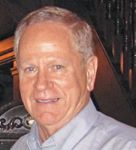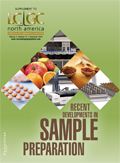Recent Developments in Sample Preparation
Special Issues
To keep readers informed of the latest developments and trends in sample preparation, LCGC North America occasionally runs reader- and expert-surveys that provide information on overall technology and usage patterns.
To keep readers informed of the latest developments and trends in sample preparation, LCGC North America occasionally runs reader- and expert-surveys that provide information on overall technology and usage patterns. In addition, special issues on popular topics of the time bring together a host of experts who cover their specific areas of expertise in more depth than might be warranted in a monthly guest author column. In the past, we have assembled special issues on Current Trends and Developments in Sample Preparation (1), Sample Preparation of Solids (2), and Sample Preparation of Volatiles (3). Since the last special issue, some of the sample preparation technologies that were new then have advanced further so it is time to re-visit those technologies to see what improvements have been made. In addition, we will look at some newer trends, particularly in the area of green sample preparation and automation.
Technologies for the extraction of solid materials have come a long way since the advent of the Soxhlet extractor, particularly in the automation of solid sample preparation techniques. In comparing this year's reader survey on sample preparation trends (4) to the last reader survey (5), the techniques of supercritical-fluid extraction (SFE), pressurized-fluid extraction (PFE), and microwave-accelerated (or assisted) extraction (MAE) have all shown substantial growth. Of the readers surveyed, SFE usage went from 1.9% to 3.7%, PFE from 5.8% to 8.0%, and MAE from 2.6% to 8.0%. All three techniques haven't surpassed more popular techniques such as solid-phase extraction (SPE) and solid-phase microextraction (SPME) but have established themselves particularly in the environmental, food safety and natural products markets. To bring us up-to-date in SFE, Professor Larry Taylor of the Department of Chemistry, Virginia Tech provides a good perspective on why this extraction technique, so popular in the 1990s, is coming "back to the future" by providing a safer, greener, and rapid method for not only non-polar compounds but for polar compounds as well. Part of the answer lies with the introduction of the latest generation of supercritical-fluid chromatography (SFC) instrumentation. On the PFE front (also referred to as accelerated solvent extraction [ASE]), Aaron Kettle from Thermo Fisher Scientific reviews the latest instrumentation developments as well as selected applications of this rapid extraction technique. For MAE, Greg LeBlanc and coworkers from the CEM Corporation provide an in-depth update on greatly improved instrumentation in the field as well as some novel applications.
Since the last special issue, the movement towards green chemistry has been a driving force in chemistry in general and analytical chemistry and sample preparation in particular. Professor Douglas Raynie and his graduate student Victor Essel from the Department of Chemistry and Biochemistry, South Dakota State University discuss green chemistry perspectives on analytical extractions. Reduced solvent consumption, safer solvent alternatives and reasonable energy demands all contribute to a greener environment. In that respect, Professor Roger Smith of the Chemistry Department of Loughborough University in the United Kingdom has a lot of experience in the use of superheated water as an extraction solvent and it is amazing the dissolution power that this entirely safe solvent can provide for organic compounds when heated well above its boiling point. He will provide a nice overview of the role of this novel extraction solvent in sample preparation.
Finally, if sample loads eventually increase enough, safety concerns arise or labor costs become an issue, automation becomes necessary part of the sample preparation portion of the analytical cycle. Most chromatography laboratories use autosamplers as the standard form of sample injection but modern instrumentation permits automation beyond injection. Edward Pfannkoch from Gerstel USA has a good handle on the role of sample preparation beyond the autosampler and will discuss the various steps prior to injection that are now automatable, freeing up the user to perform less routine tasks.
If you are faced with sample preparation challenges in your own laboratory, I hope you find something of interest in this special issue of LCGC North America.
References
(1) R.E. Majors, Ed. "Current Trends and Developments in Sample Preparation", LCGC, 16(5S), S1–S60 (1998).
(2) R.E. Majors, Ed. "Sample Preparation of Solids", LCGC, 17 (6S), S1–S44 (1999).
(3) R.E. Majors, Ed. "Sample Preparation for Volatile Compounds", LCGC, 17(9S), S1-S36 (1999).
(4) R.E. Majors, LCGC North Am. 31(3), 190–203 (2013).
(5) R.E. Majors, LCGC 20(12), 1098–1113 (2002).
Ronald E. Majors LCGC Sample Preparation Perspectives Column Editor

Ronald E. Majors

Thermodynamic Insights into Organic Solvent Extraction for Chemical Analysis of Medical Devices
April 16th 2025A new study, published by a researcher from Chemical Characterization Solutions in Minnesota, explored a new approach for sample preparation for the chemical characterization of medical devices.
Study Explores Thin-Film Extraction of Biogenic Amines via HPLC-MS/MS
March 27th 2025Scientists from Tabriz University and the University of Tabriz explored cellulose acetate-UiO-66-COOH as an affordable coating sorbent for thin film extraction of biogenic amines from cheese and alcohol-free beverages using HPLC-MS/MS.
Multi-Step Preparative LC–MS Workflow for Peptide Purification
March 21st 2025This article introduces a multi-step preparative purification workflow for synthetic peptides using liquid chromatography–mass spectrometry (LC–MS). The process involves optimizing separation conditions, scaling-up, fractionating, and confirming purity and recovery, using a single LC–MS system. High purity and recovery rates for synthetic peptides such as parathormone (PTH) are achieved. The method allows efficient purification and accurate confirmation of peptide synthesis and is suitable for handling complex preparative purification tasks.

.png&w=3840&q=75)

.png&w=3840&q=75)



.png&w=3840&q=75)



.png&w=3840&q=75)






